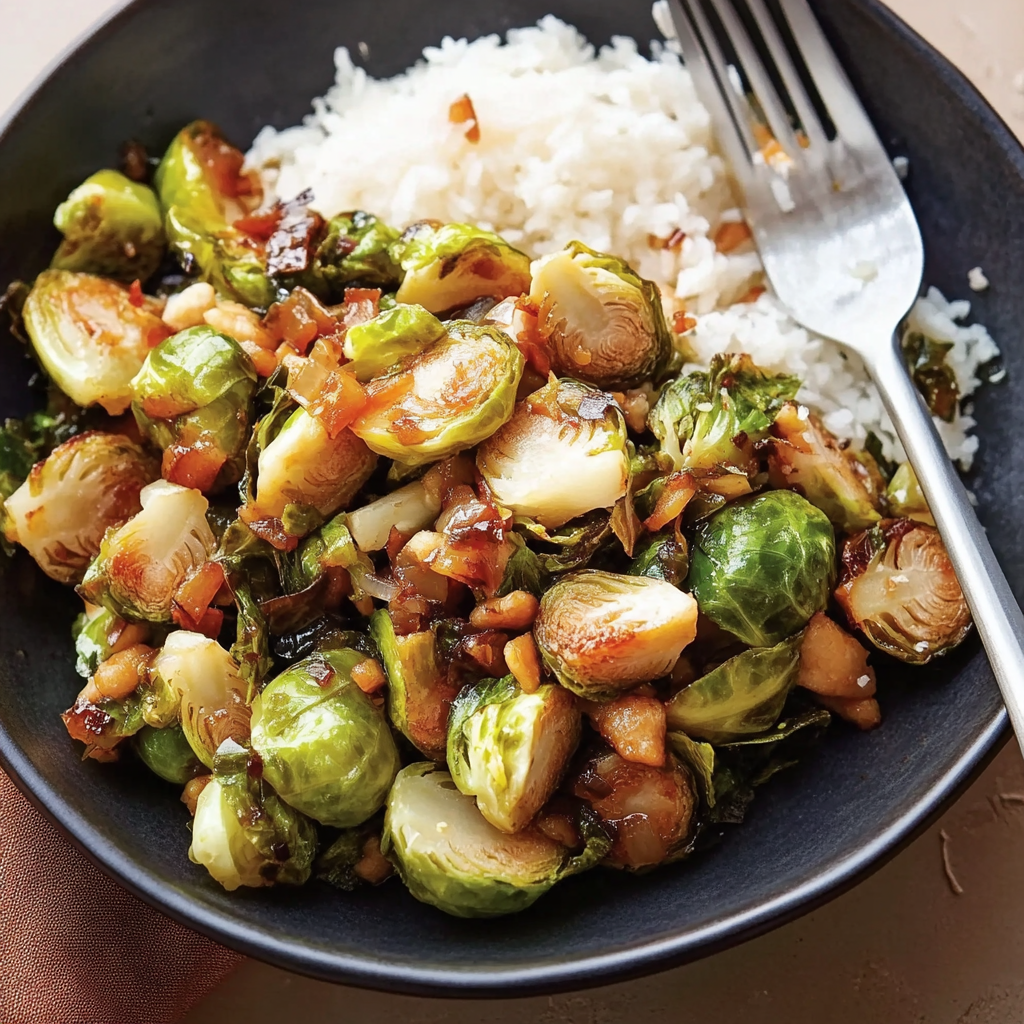Sharing is caring!
Brussels Sprouts Stir-Fry
Why You’ll Love Brussels Sprouts Stir-Fry?
Brussels sprouts stir-fry is a game-changer for busy weeknights or when you crave something nutritious yet bursting with flavor. This dish combines crispy Brussels sprouts with savory seasonings, creating a perfect balance of texture and taste. Whether you’re a veggie lover or just looking for a quick, healthy meal, this recipe is a must-try. Pair it with our teriyaki noodles for a complete, satisfying dinner.
Table of Contents
- Ingredients to make Brussels Sprouts Stir-Fry
- Time needed to make brussels sprouts stir fry?
- Quick Steps to Make Brussels Sprouts Stir-Fry?
- Is brussels sprouts stir fry healthy and nutritious ?
- Can I make brussels sprouts stir fry healthier and still delicious?
- How to Serve Brussels Sprouts Stir-Fry?
- Avoid These Mistakes
- The best way to store leftover brussels sprouts stir fry
- Ready to give brussels sprouts stir fry a try?
- Frequently Asked Questions
Ingredients to make Brussels Sprouts Stir-Fry
- 1 lb Brussels sprouts, trimmed and halved
- 2 tbsp olive oil
- 3 cloves garlic, minced
- 1 tbsp soy sauce (or tamari for gluten-free)
- 1 tsp honey (or maple syrup for vegan option)
- 1 tsp red pepper flakes (adjust to taste)
- 1 tbsp sesame seeds
- Salt and black pepper to taste
- 1 tbsp lemon juice (optional, for brightness)
Time needed to make brussels sprouts stir fry?
This quick and flavorful brussels sprouts stir fry comes together in just 15 minutes—perfect for busy weeknights. Here’s the breakdown:
- Prep time: 5 minutes (washing, trimming, and slicing sprouts)
- Cook time: 10 minutes (stir-frying to crispy perfection)
- Total time: 15 minutes
For more speedy vegetable dishes, try our roasted cauliflower salad or cauliflower fried rice, both ready in under 30 minutes.
Quick Steps to Make Brussels Sprouts Stir-Fry?
Step 1: Prep Your Brussels Sprouts
Wash and trim the Brussels sprouts, then slice them thinly for quick cooking. You can also shred them using a food processor for a finer texture.
Step 2: Heat Your Pan
Heat a large skillet or wok over medium-high heat. Add a tablespoon of oil (like olive or sesame oil) and let it warm up for about 30 seconds.
Step 3: Sauté Aromatics
Add minced garlic and ginger to the hot oil, stirring for 15-20 seconds until fragrant. Be careful not to burn them!
Step 4: Cook the Brussels Sprouts
Toss in the sliced Brussels sprouts, stirring frequently to ensure even cooking. Cook for 5-7 minutes until they start to soften and turn bright green.
Step 5: Add Seasonings
Drizzle with soy sauce (or tamari for gluten-free) and a splash of rice vinegar. Toss well to coat all the sprouts evenly.
Step 6: Finish & Serve
Cook for another 2-3 minutes until the Brussels sprouts are tender but still slightly crisp. Garnish with sesame seeds or red pepper flakes for extra flavor. Serve immediately while hot!
Is brussels sprouts stir fry healthy and nutritious ?
Brussels sprouts stir fry is packed with essential nutrients, making it a powerhouse of health benefits. A single serving provides a rich dose of fiber, vitamin C, vitamin K, and antioxidants. These nutrients support digestion, immunity, and even heart health. For a deeper dive into nutrient-rich meals, check out our roasted cauliflower salad, another veggie-loaded dish.
This dish is naturally low in calories but high in flavor, making it perfect for weight management. The stir-frying method helps retain more nutrients compared to boiling, ensuring you get the most out of every bite. If you’re looking for more protein-packed options, our chicken cauliflower fried rice is a great alternative.
For additional insights on balancing macros, slow-cooker beef stew offers a hearty, nutrient-dense option. Meanwhile, vegan split pea soup is another fiber-rich dish worth exploring.
Can I make brussels sprouts stir fry healthier and still delicious?
Absolutely! You can easily make your brussels sprouts stir fry healthier without sacrificing flavor. Here are some simple swaps and tips to boost nutrition while keeping it tasty:
Smart Ingredient Swaps:
- Use avocado oil or coconut oil instead of vegetable oil for healthier fats
- Try low-sodium tamari or coconut aminos instead of regular soy sauce
- Add extra veggies like roasted cauliflower or bell peppers for more fiber
Protein Boosters:
- Add lean proteins like air-fried fish or grilled chicken
- For plant-based protein, try tofu or tempeh (check out this vegan protein inspiration)
Cooking Method Tweaks:
- Reduce oil by using a non-stick pan or healthier cooking techniques
- Roast the sprouts first for deeper flavor with less oil
For more healthy cooking ideas, explore these nutritious recipe transformations that keep all the flavor while cutting unnecessary calories.
How to Serve Brussels Sprouts Stir-Fry?
This vibrant brussels sprouts stir fry pairs beautifully with a variety of dishes. For a light yet satisfying meal, serve it alongside a roasted cauliflower salad or a protein-packed chicken cauliflower fried rice.
If you’re craving something heartier, try pairing it with a comforting classic beef stew or barbecue roasted chicken for a well-rounded dinner. The crisp-tender texture of the brussels sprouts stir fry contrasts wonderfully with these richer dishes.
For an elegant presentation, garnish with toasted sesame seeds or chopped cashews. A squeeze of fresh lime juice just before serving brightens all the flavors beautifully.
Avoid These Mistakes
Even the simplest dishes can go wrong if you overlook key details. Here are common pitfalls to avoid when making brussels sprouts stir fry—and how to fix them:
1. Overcrowding the Pan
Piling too many sprouts into the pan steams them instead of searing. For crispy, caramelized edges, cook in batches if needed. A single layer ensures even browning—just like with this roasted cauliflower salad.
2. Skipping the Blanching Step
Raw brussels sprouts can taste bitter. Blanching them for 2 minutes in boiling water softens their bite. For more veggie prep tips, check out this guide to balancing flavors.
3. Using Low Heat
A medium-high heat is essential for that signature stir-fry char. Too low, and you’ll end up with soggy sprouts. Need a crispy alternative? Try these golden chicken cutlets for texture inspiration.
4. Forgetting to Season in Layers
Salt early (during blanching) and again while stir-frying. For depth, add umami-rich ingredients like soy sauce or fish sauce. The slow-cooker beef stew method proves how layering flavors elevates a dish.
5. Overcooking Garlic or Ginger
Burnt aromatics turn bitter. Add minced garlic and ginger in the last 30 seconds of cooking. For more aromatic tricks, this dessert guide highlights delicate flavor pairings.
The best way to store leftover brussels sprouts stir fry
To keep your brussels sprouts stir fry fresh, transfer it to an airtight container and refrigerate within 2 hours of cooking. It stays fresh for up to 3–4 days. For longer storage, freeze portions in freezer-safe bags for up to 2 months—just thaw overnight in the fridge before reheating. For best results, reheat in a skillet over medium heat with a splash of water or broth to revive the texture. Avoid microwaving, as it can make the sprouts mushy. Pair your leftovers with this crispy air-fryer sea bass for a quick meal, or check out slow-cooker stew tips for more storage hacks. Need reheating ideas? Try these teriyaki noodles alongside your stir-fry, or explore spicy split pea soup for freezer-friendly inspiration.
Ready to give brussels sprouts stir fry a try?
This quick and flavorful brussels sprouts stir fry is a game-changer for busy weeknights or when you crave something nutritious yet delicious. With just 15 minutes of cooking time, it’s a perfect way to enjoy crispy, caramelized sprouts paired with savory seasonings. If you loved this recipe, explore more veggie-packed dishes like our roasted cauliflower salad or vegetable quiche for wholesome meals. For protein-rich options, try our breaded chicken cutlets or teriyaki noodles with shrimp and steak to round out your menu. Happy cooking!
Frequently Asked Questions
Can I use frozen Brussels sprouts for this stir-fry?
Yes, frozen Brussels sprouts work well, but thaw and pat them dry before cooking to avoid excess moisture.
How can I make this Brussels sprouts stir-fry spicier?
Add red pepper flakes, sriracha, or diced jalapeños while stir-frying for extra heat.
Is this recipe gluten-free?
It can be! Just swap soy sauce for tamari or coconut aminos to keep it gluten-free.
Can I add protein to this dish?
Absolutely! Tofu, chicken, shrimp, or beef make great additions—just cook them first before adding the sprouts.
How long do leftovers last in the fridge?
Store in an airtight container for up to 3 days. Reheat in a pan for best texture.










